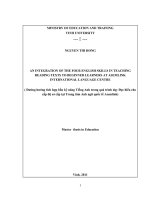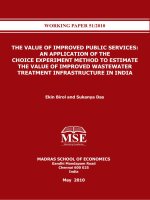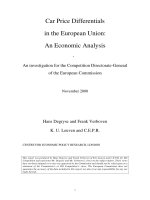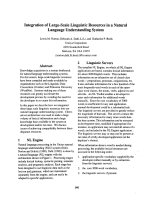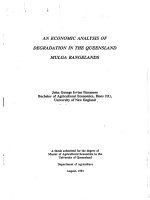An integration of major coffee consuming centres in India – An economic analysis
Bạn đang xem bản rút gọn của tài liệu. Xem và tải ngay bản đầy đủ của tài liệu tại đây (298.39 KB, 8 trang )
Int.J.Curr.Microbiol.App.Sci (2018) 7(3): 1090-1097
International Journal of Current Microbiology and Applied Sciences
ISSN: 2319-7706 Volume 7 Number 03 (2018)
Journal homepage:
Original Research Article
/>
An Integration of Major Coffee Consuming
Centres in India – An Economic Analysis
M. Balakrishnan* and K. Chandran
Department of Agricultural Economics, Tamil Nadu Agricultural University, Coimbatore,
Tamil Nadu - 641 003, India
*Corresponding author
ABSTRACT
Keywords
Coffee, Agricultural
commodities,
Economic analysis
Article Info
Accepted:
10 February 2018
Available Online:
10 March 2018
The price signals of agricultural commodities from markets located in different locations
play a very important role in the economy. The price signals guide and regulate
production, consumption and marketing decisions over time. Therefore, if markets are not
well integrated, the price signals are distorted, which will lead to inefficient resource
allocation and hamper sustainable agricultural development. This paper employs an
econometric modeling for estimating a vector error correction model (VECM) to
investigate the degree of spatial market integration and price transmission between the
important coffee consuming centers in India (viz. Bangalore, Chennai and Hyderabad)
using month-wise wholesale prices of coffee seeds. The bidirectional causality among the
monthly Wholesale Prices of Rs/kg of clean coffee seeds of Arabica Parchement variety in
Bangalore and Chennai markets. There was a long-run co integration relationship between
Hyderabad consuming centre and Bangalore consuming centre with other consuming
centre as the co integration coefficient for these consuming centres are Positive and
significant at one per cent level. Similarly, it was found that a long-run co integration
relationship between Bangalore consuming centre with other consuming centres as the co
integration coefficient for Bangalore consuming centre is Positive and significant at one
per cent level.
Introduction
Coffee production in India grew rapidly in the
1950s, increasing from 18,893 tonnes in 195051 to 68,169 tonnes in 1960-61. Growth in
India’s coffee industry, however, has been
especially robust in the post-liberalisation era,
backed by the government’s decision to allow
coffee planters to market their own produce,
rather than selling to a central pool. Coffee
production in India stood at 348,000 metric
tonnes (MT) in 2015-16. Robusta variety
accounted for 244,500 MT (70.3 per cent) of
this production, while Arabica accounted for
103,500 MT (29.7 per cent). The post-blossom
estimate for 2016-17 is 320,000 MT (100,000
MT of Arabica and 220,000 MT of Robusta)
India has emerged as the seventh largest
coffee producer globally; after Brazil,
Vietnam, Columbia, Indonesia, Ethiopia and
Honduras. It accounted for 2 per cent of the
area under production and 3.7 per cent of the
1090
Int.J.Curr.Microbiol.App.Sci (2018) 7(3): 1090-1097
production in 2012 as compared to 3.18 per
cent of production in 1992-93. In 2015-16,
India accounted for 4.05% of global coffee
production.
Coffee is grown in three regions of India with
Karnataka, Kerala and Tamil Nadu forming
the traditional coffee growing region of India,
followed by the new areas developed in the
non-traditional areas of Andhra Pradesh and
Orissa in the eastern coast of the country and
with a third region comprising the states of
Assam, Manipur, Meghalaya, Mizoram,
Tripura, Nagaland and Arunachal Pradesh
of Northeastern India, popularly known as
“Seven Sister States of India”.
The area under coffee plantations in India has
increased by more than three times, from
120.32 thousand hectares in 1960-61 to
397.147 thousand hectares in 2015-16. Most
of this area is concentrated in the southern
states of Karnataka (54.95%), Kerala
(21.33%) and Tamil Nadu (8.18%).
Productivity has also improved from around
567 kg/Ha in 1961 to around 876 kg/Ha
during 2015-16. For the traditional areas,
productivity has grown from 412 kg/Ha in
1961 to 1,008 kg/Ha in 2015-16. The industry
is driven by the enterprise of around 280,241
coffee growers, out of which 99% are small
growers, while 1% are medium to large
growers. These plantations employ an average
of around 632,993 people on a daily basis, as
per estimates for 2015-16. There are
approximately 250,000 coffee growers in
India; 98 per cent of them are small
growers. Over 90 percent of them are small
farms consisting of 10 acres (4.0 ha) or fewer.
According to published statistics for 2001–
2002, the total area under coffee in India was
346,995 hectares (857,440 acres) with small
holdings of 175,475 accounting for 71.2 per
cent. The area under large holding of more
than 100 hectares (250 acres) was 31,571
hectares (78,010 acres) (only 9.1 per cent of
all holdings) only under 167 holdings. The
area under less than 2 hectares (4.9 acres)
holdings was 114,546 hectares (283,050 acres)
(33 per cent of the total area) among 138,209
holders. Among the states, the final estimate
for Karnataka is placed at 221,745 MT
comprising of 70,510 MT of Arabica and
151,235 MT of Robusta, recording a decline
of 4,555 MT (-2.01per cent) over the postmonsoon estimate of 2016-17. The production
of Arabica has declined by 1,090 MT (1.52per cent) and Robusta declined by 3,465
MT (-2.24per cent) over the post monsoon
estimate. Among the districts, the major loss
of about 4,290 MT is reported from Kodagu
district. In Kerala, the final estimate of 201617 is placed at 63,265 MT with a marginal
decline of 25 MT (-0.04per cent) over the post
monsoon estimate (63,290 MT) of 201617.The Tamil Nadu, the final production of
2016-17 is placed at 16,335 MT which is a
marginal decline of 225 MT (-1.36per cent)
over the post monsoon estimate (16,560 MT)
of 2016-17.
Coffee is world famous beverage and is
widely drunk almost every part of the world.
This drink is made from coffee seeds which
are also referred to as “beans”. The total
coffee production in the world is around six
million tons and India share 4.5% of total
production in the world. Coffee production in
India is mainly concentrated in the southern
part of the country in which Karnataka is the
leading coffee producer followed by Kerala
and Tamil Nadu. Almost 80% of country’s
coffee production is exported to different
country. In our country, mainly two types of
coffee varieties are cultivated. Robusta coffee
or Coffearobusta is grown around 52% of total
coffee area and arabica coffee or
Coffeaarabica is grown around 48% of the
total coffee area. Considering the sustainable
source of foreign exchange earnings to Indian
economy, it is therefore important to analyze
countries major coffee marketing system so
1091
Int.J.Curr.Microbiol.App.Sci (2018) 7(3): 1090-1097
that countries coffee production as well as
export is efficiently managed. Presence of
perfect market integration and price
transmission are very important phenomenon
to be considered for efficient management of
marketing system. In an efficient marketing
system, new information is confounded
simultaneously into markets when they are
cointegrated. This type of system has a
considerable significance for deriving
maximum gains for producers, consumers and
middleman in the marketing chain. Currently
financial markets are characterized by
increasing volatility. Commodity market or
the coffee market is prone to abrupt
movements (Huchet, 2011). Increased
variability in prices occurs in these markets,
particularly in the "post-crisis" period (Engle
et al., 2013). Commodity markets play an
important role in the global financial system
(Irwin, S.H., P. Garcia, D.L. Good, and E.L.
Kunda, 2008). This paper has highlighted the
degree of market integration among major
coffee centers in India such as Bangalore,
Chennai and Hyderabad. The nature of
cointegration and extent of price adjustment
for different markets has been evaluated.
Depending on the market structure, the
direction of price transmission among
different markets has been investigated as it
provides valuable information on the degree of
integration and efficiency of markets. Finally
an effort is made for forecasting the
performance of spatially separated markets.
Data sources and methodology
For the present study, the time series data on
monthly Wholesale Prices of Rs/kg of clean
coffee seeds of Arabica Parchement variety in
major Consuming Centres viz., Chennai,
Bangalore and Hyderabad prices of coffee
(Jan 2009 to November 2017) are sourced
from coffee board. The ultimate aim of present
study is to examine the empirical relationship
between the prices among the markets. The
problem with approaching time series data is
the problem of non stationarity. Before
analyzing any time series data, testing for
stationarity is a prerequisite since econometric
relation between the time series has the
presence of trend components. This involved
testing for stationarity of the variables using
Augmented Dickey Fuller (ADF) test. The
ADF tests mentioned above consider the null
hypothesis that a given series has a unit root,
i.e., it is non stationary. The test is applied by
running the regression of the following form:
Yt 1 Yt 1 i Yt 1 et
If the coefficient δ is not statistically different
from zero, it implies that the series have a unit
root, and, therefore, the series is nonstationary. To verify that the first differenced
price series are indeed stationary, Augmented
Dickey-Fuller (ADF) unit root tests are used.
The null hypothesis of non - stationary is
tested using a t-test.
The null hypothesis is rejected if estimated
variable is significantly negative. For testing
stationarity in the above equation, Yi denoted
the Wholesale Prices of Rs/kg of clean coffee
seeds of arabicaparchement variety in major
Consuming Centres viz., Chennai, Bangalore
and Hyderabad prices of coffee (Jan 2009 to
November 2017). i= 1, 2 and 3 (1-Chennai; 2Bangalore and 3 - Hyderabad [t-1: 1 month
lagged price and ∆: differenced series] (Note:
CBPL, CHPL and CHPL – Wholesale Prices
of Rs/kg of clean coffee seeds of
arabicaparchement variety).
Once the variables are checked for stationarity
and are of the same order, integration between
them can be tested using methods such as
Augmented Dickey Fuller Test or Johansen
Maximum Likelihood Test in a bivariate as
well as multivariate framework. If the
estimated value of error term exceeds critical
values at one percent, five percent and 10
percent levels of significance, the conclusion
1092
Int.J.Curr.Microbiol.App.Sci (2018) 7(3): 1090-1097
would be that the residual term is stationary
and hence the two individual series, through
non-stationary, are co-integrated in the long
run.
The Granger test is based on a premise that if
forecasts of some variable, say X, obtained by
using both the past values of X and the past
values of another variable Y, is better than the
forecasts obtained using past values of X
alone, Y is then said to cause X. The model
proposed by Granger was:
Yi ai Yt i bi X t i ei
(1)
X i ci Yt i d i X t i vi
(2)
X i and Yi are two stationary time
e
v
series with zero mean: i and i are two
uncorrelated series, lag length is assumed to
be finite and shorter than the time series
considered. Since the series of the variable are
usually non-stationary and integrated of order
I (1), first difference of the variable is
normally taken which is stationary. The
optimal lag length of the variables is
determined
by
minimizing
Akaike’s
Information Criterion. Based on equations 1
and 2, unidirectional causation from one
variable X to Y (i.e. X Granger causes Y )
is observed if the estimated coefficient on the
lagged X variable in equation (1) is
statistically non-zero as a group and the set of
lagged Y coefficient is zero in equation (2).
Similarly, unidirectional causation from Y to
X (i.e. Y Granger causes X ) is implied if
the estimated coefficient on the lagged Y in
equation (2) are statistically different from
zero as a group and the set of estimated
coefficient on the lagged X variable in
equation (1) is not statistically different from
zero. Feedback or mutual causality (bidirectional) would occur when the set of
Where,
coefficients on the lagged X variable in
equation (1) and on lagged variable Y in
equation (2) are statistically different from
zero. Finally, independence exists when the
coefficients of both X and Y variables are
equal to zero. For the proposed study, Xi and
Yi denoted the Wholesale Prices of Rs/kg of
clean coffee seeds of Arabica Parchement
variety in major Consuming Centres viz.,
Chennai, Bangalore and Hyderabad (Note:
CBPL, CHPL and CHPL – Wholesale Prices
of Rs/kg of clean coffee seeds of Arabica
Parchement).
An Error Correction Model (ECM) is a neat
way of combining the long run, co integrating
relationship between the levels variables and
the short run relationship between the first
differences of the variables. It has also had the
advantage that all the variables in the
estimated equation are stationary, hence there
is no problem of spurious correlation. Engel
and Granger (1987) demonstrated that once a
number of variables are found to be co
integrated, then there existed a corresponding
error correction representation which implied
that the changes in the dependent variable are
a function of the level of disequilibrium in the
co integrating relationship as well as changes
in other variables. If the price series are I (1),
then one could run regressions in their first
differences. However, by taking first
differences, we lose the long run relationship
that is stored in the data which implied use of
variables in levels as well. Advantage of error
correction methodology is that it incorporates
variables both in their levels and first
differences. By doing this, ECM captures the
short run equilibrium situations as well as the
long run equilibrium adjustments between
prices.
Even if one demonstrates market integration
through co integration, there could be
disequilibrium in the short run, i.e., price
adjustment across markets may not happen
1093
Int.J.Curr.Microbiol.App.Sci (2018) 7(3): 1090-1097
instantaneously. It may take some time for the
spatial price adjustments. ECM can
incorporate such short run and long run
changes in the price movements.
A generalized ECM formulation to understand
both the short run and long run behaviour of
prices can be considered by the first taking the
Autoregressive Distributed Lag (ADL)
equation as follows:
Yt a01 X t a11 X t 1 a12Yt 1 t .
Yt 1 , a01 X t 1 ,
By adding and deleting
rearranging terms, and using the difference
equator, the above equation can be written in
the ECM format as follows:
(a a )
Yt a01X t (1 a12 ) 01 11 X t 1 Yt 1 t
(1 a12 )
.
The generalized form of this equation for k
lags and an intercept term is as follows:
k 1
k 1
i 0
i 1
Yt a00 ai1X t 1 ai 2 Yt 1 m0 m1 X t k Yt k t
measures the rate of adjustment of the short
run deviations towards the long run
equilibrium. Theoretically, this parameter lies
between 0 and 1. The value 0 denotes no
adjustment and 1 indicates an instantaneous
adjustment. A value between 0 and 1 indicates
that any deviations will have gradual
adjustment to the long run equilibrium values.
So the Vector Error Correction Mechanism is
used to distinguish short term from long term
association of the variables included in the
model. When the variables are not integrated,
then in the short term deviation from this longterm equilibrium would feed back to the
changes in the dependent variable in order to
force the movement according to the long run
equilibrium relationship. The long term causal
relationship among the future markets is
implied through the significance of ‘t’ tests of
the lagged error correction term as it contains
the long term information because it is derived
from the long term relationship. The
coefficient of the lagged error correction term
is a short-term adjustment coefficient and
represented the proportion by which the
commodity futures adjusted with exchange
rate to respond to the long run disequilibrium.
Results and Discussion
k
ai1
k
i 0
m 0 1 a i 2
m1
m0 .
i 1
Where,
, and
If all the variables are I(1), i.e., they are
integrated of order 1, they are stationary in
first difference. Therefore, all the summations
in the above equations are also stationary.
Moreover, if the variables are cointegrated, the
ECM term, i.e., the linear combination of
variables represented in parentheses is also
stationary. The aij coefficients capture the
short run effects and mj coefficients represent
the stationary long run impacts of the right
hand side variables. The parameter m0
To verify level and first differenced price
series were indeed stationary, Augmented
Dickey-Fuller (ADF) unit root test was used.
The ADF test results are presented for the
period Jan 2009 to November 2017. The
equations were estimated with an intercept and
time trend.
The results are presented in Table 1 for
Augmented Dickey-Fuller (ADF) unit root
tests for each series. The null hypothesis of
non - stationarity was tested based on the
critical values reported by MacKinnon.
1094
Int.J.Curr.Microbiol.App.Sci (2018) 7(3): 1090-1097
Table.1 Results of unit root test (ADF test)
Variable
Level
Lags
First difference
Lags
CBPL
-2.6062
(1)
-7.8554***
(0)
CHPL
-2.6644
(1)
-11.2453***
(0)
CCPL
-2.8758
(1)
-9.3619***
(0)
{Note: Figures in parentheses are the number of significant lags
*** Significant at 1 percent level
CBPL, CHPL & CCPL – monthly Wholesale Prices of Rs/kg of clean coffee seeds of Arabica Parchement variety in
major Consuming Centres viz., Chennai, Bangalore and Hyderabad
Table.2 Results of causality test
Null hypothesis
F – statistic
HPL does not Granger Cause BPL
0.66001
0.5191
BPL does not Granger Cause HPL
13.8600
5.E-06
CPL does not Granger Cause BPL
2.84181
0.0630
BPL does not Granger Cause CPL
8.80832
0.0003
CPL does not Granger Cause HPL
1.96810
0.1451
HPL does not Granger Cause CPL
3.96886
0.0219
P -value
** Significant at 5 percent level, * significant at 10 percent level, NS – Not significant
The test for causality is based on F statistics that is calculated by using unconstrained and constrained forms,
F= {SSEr + SSEf)/ m} / {SSEf/ (T-2m-1)},
Where SSEr and SSEf are residual sum of squares of the reduced and full models respectively; T= total number of
observations, and m= number of lags.
{CBPL, CHPL & CCPL – monthly Wholesale Prices of Rs/kg of clean coffee seeds of Arabica Parchement variety
in major Consuming Centres viz., Chennai, Bangalore and Hyderabad}
Table.3 Results of multiple co-integration tests
Trace statistics of Series BPL, HPL & CPL
No. of CE(s)
Eigenvalue
Statistic
Critical value
Probability
None
0.25413
37.7578***
24.2759
0.0006
At most 1
0.0708
7.8500
12.3209
0.2485
At most 2
0.0034
0.3557
4.1299
0.6137
Critical values based on MacKinnon (1991). LR test indicated 1 co-integrating equation significant at 5 per cent
level.
{Note: {CBPL, CHPL & CCPL – monthly Wholesale Prices of Rs/kg of clean coffee seeds of Arabica Parchement
variety in major Consuming Centres viz., Chennai, Bangalore and Hyderabad}
1095
Int.J.Curr.Microbiol.App.Sci (2018) 7(3): 1090-1097
Table.4 Reduced form vector error correction estimates
Error Correction
ECM
D(HPL(-1))
D(HPL(-2))
D(CPL(-1))
D(CPL(-2))
D(BPL(-1))
D(BPL(-2))
c
R-squared
Adj.R-squared
AIC
D(HPL)
-0.010653
(0.09337)
[-0.11410]
-0.407491
(0.13669)
[-2.98104]
-0.182958
(0.12790)
[-1.43052]
-0.047653
(0.11782)
[-0.40446]
0.004418
(0.11718)
[ 0.03771]
0.550923
(0.15109)
[ 3.64643]
0.377128
(0.15304)
[ 2.46417]
1.1250
0.208313
0.150586
8.538042
D(CPL)
0.497362
(0.11577)
[ 4.29626]
-0.231858
(0.16948)
[-1.36804]
-0.262803
(0.15857)
[-1.65730]
0.319134
(0.14608)
[ 2.18466]
0.133460
(0.14529)
[ 0.91858]
0.251740
(0.18732)
[ 1.34387]
0.222136
(0.18975)
[ 1.17066]
0.7311
0.226377
0.169967
8.968039
D(BPL)
0.137055
(0.07766)
[ 1.76485]
-0.198259
(0.11369)
[-1.74385]
-0.166862
(0.10637)
[-1.56865]
0.283957
(0.09799)
[ 2.89775]
0.116563
(0.09746)
[ 1.19598]
0.116158
(0.12566)
[ 0.92438]
0.177578
(0.12729)
[ 1.39507]
0.2491
0.151861
0.090018
8.169515
Note: Bold and italics are the significant variables
{CBPL, CHPL & CCPL – monthly Wholesale Prices of Rs/kg of clean coffee seeds of Arabica Parchement variety
in major Consuming Centres viz., Chennai, Bangalore and Hyderabad}
All the price series appeared non stationary in
the levels, but all the series were stationary after
taking first differences. After confirming the
currency exchange rates were stationary in their
first differences, co integration between the
commodity futures was tested using Johansen’s
maximum likelihood procedure.
The bivariate co integration technique of Engle
and Granger was also tested for the presence of
long run relationship existing between the
monthly Wholesale Prices of Rs/kg of clean
coffee seeds of Arabica Parchement variety in
major Consuming Centres viz., Chennai,
Bangalore and Hyderabad.
The causal relationship between the exchange
rates of monthly Wholesale Prices of Rs/kg of
clean coffee seeds of Arabica Parchement
variety in major Consuming Centres were
approached through Granger’s Causality
technique presented in Table 2. It could be seen
that existence of unidirectional causality among
the monthly Wholesale Prices of Rs/kg of clean
coffee seeds of Arabica Parchement variety in
major Consuming Centres viz., Chennai,
Bangalore and Hyderabad exerted mutual
influence upon each other during the
investigation period.
1096
Int.J.Curr.Microbiol.App.Sci (2018) 7(3): 1090-1097
The bidirectional causality among the monthly
Wholesale Prices of Rs/kg of clean coffee seeds
of Arabica Parchement variety in Bangalore and
Chennai markets.
Results of co-integration analysis of presented
in Table 3 revealed that there were one cointegrating vectors among them, which proved
that there was a long run relationship among the
monthly Wholesale Prices of Rs/kg of clean
coffee seeds of Arabica Parchement variety in
major Consuming Centres viz., Chennai,
Bangalore and Hyderabad.
Vector error correction estimates
To know the short run adjustment between the
selected markets, VECM was computed and the
results are presented in Table 4. The estimates
of error correction coefficients confirmed that
the Tamil Nadu Chennai market came to
equilibrium under short run when compared to
other markets. The speed of adjustment for
short run equilibrium by the Tamil Nadu market
was rapid as seen from the error correction
equation. But under long run, the major
consuming centres were influenced by their
own lag as well as lag price of other markets in
India. There was a long-run co integration
relationship between Hyderabad consuming
centre and Bangalore consuming centre with
other consuming centre as the co integration
coefficient for these consuming centres are
Positive and significant at one per cent level.
Similarly, it was found that a long-run co
integration relationship between Bangalore
consuming centre with other consuming centres
as the co integration coefficient for Bangalore
consuming centre is Positive and significant at
one per cent level.
From all the above results, it is concluded that
the existence of unidirectional causality among
the monthly Wholesale Prices of Rs/kg of clean
coffee seeds of Arabica Parchement variety in
major Consuming Centres viz., Chennai,
Bangalore and Hyderabad exerted mutual
influence upon each other during the
investigation period. The bidirectional causality
among the monthly Wholesale Prices of Rs/kg
of clean coffee seeds of Arabica Parchement
variety in Bangalore and Chennai markets.
There was a long-run co integration relationship
between Hyderabad consuming centre and
Bangalore consuming centre with other
consuming centre as the co integration
coefficient for these consuming centres are
Positive and significant at one per cent level.
Similarly, it was found that a long-run co
integration relationship between Bangalore
consuming centre with other consuming centres
as the co integration coefficient for Bangalore
consuming centre is Positive and significant at
one per cent level.
References
Engle, Robert F. A W. J. Granger. CoIntegration and Error Correction:
Representation, Estimation, and Testing.
Econometrica. 1987
Huchet-Bourdon, M. (2011). Agricultural
Commodity
Price
Volatility:
An
Overview“, OECD Food, Agriculture and
Fisheries Papers, No. 52, OECD
Publishing.
Irwin, S.H., P. Garcia, D.L. Good, and E.L.
Kunda.
“Recent
Convergence
Performance of CBOT Corn, Soybean,
and Wheat Futures Contracts.” Choices,
2nd Quarter, 23(2008):16-21.
How to cite this article:
Balakrishnan, M. and Chandran, K. 2018. An Integration of Major Coffee Consuming Centres in
India – An Economic Analysis. Int.J.Curr.Microbiol.App.Sci. 7(03): 1090-1097.
doi: />
1097

